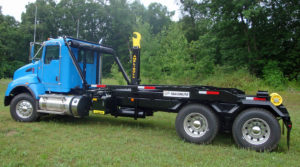Load-Holding Safety Engineering for Hydraulic Hooklift Systems

In the ongoing hydraulic hooklift system vs roll-on hoist debate, hooklifts score a major plus because of operator safety.
Unlike operating levers which are located outside on the chassis and next to cables and winches, hooklift controls are mounted inside the cab and away from moving machinery. For drivers, this minimizes the risk of injury. For fleet owners, it reduces the occurrence of worker’s compensation claims that can result from such hazards.
Of course, other hooklift engineering addresses load-handling safety. And, while all systems are not equipped exactly alike, these measures are common to many:
- Counterbalance valves: Also termed over-center valves or load-holding valves, they deliver hydraulic resistance to the actuating cylinder. This holds the load securely in position even in the event of hydraulic hose failure. Two types are used by hooklift manufacturers:
- Internal systems: An integral counterbalance valve is built directly into the main cylinder. This engineering eliminates the risk of damage to the valve by falling debris, but can sometimes require the replacement of the entire cylinder assembly at great cost as a result of the failure of just the seat or threads of the holding valve.
- External systems: A remote-mounted counterbalance valve is positioned outside the cylinder. While generally a more economical solution, this external mounting eases the replace in the event of failure without requiring the replace of the entire cylinder assembly.
- Jib safety valves: These are designed to render the jib cylinder inoperable during the dump cycle. If a driver accidentally pulls the wrong control lever during the dump cycle, the jib safety valve protects the system from damage and inadvertent possible release of container.
- Hook latch covers: Engineered to augment a hooklift’s rear-lock system while in transit, the hook latch cover seals the opening in the hook head. During transporting and dumping, it secures the lift bar inside the hook head to help keep the truck body in place.
- Proximity switches: Mounted in various locations throughout the hoist, these switches alert the driver to which part of the lift/dump cycle is current, or if there’s a fault in the system. When activated, an alarm sounds or a red warning light activates within the cab. However, these switches are subject to damage from falling debris, misalignment, and internal failure. The Ampliroll design assures safe and correct operation without requiring the use of these switches.
For more information on the load-handling safety engineering offered by the hydraulic hooklift system you’re considering, ask your dealer.
For selection, savings and service, make Ampliroll your first choice in hydraulic hooklift systems.
Ampliroll Hooklift Systems are manufactured by Marrel – the inventor of the dual-pivot hook loaderin 1969 and first again in bringing them to users across the U.S. in 1980. Today, Ampliroll is one of the nation’s leading providers of hooklift systems. Of course, we also offer high-quality pre-owned hooklift vehicles.
